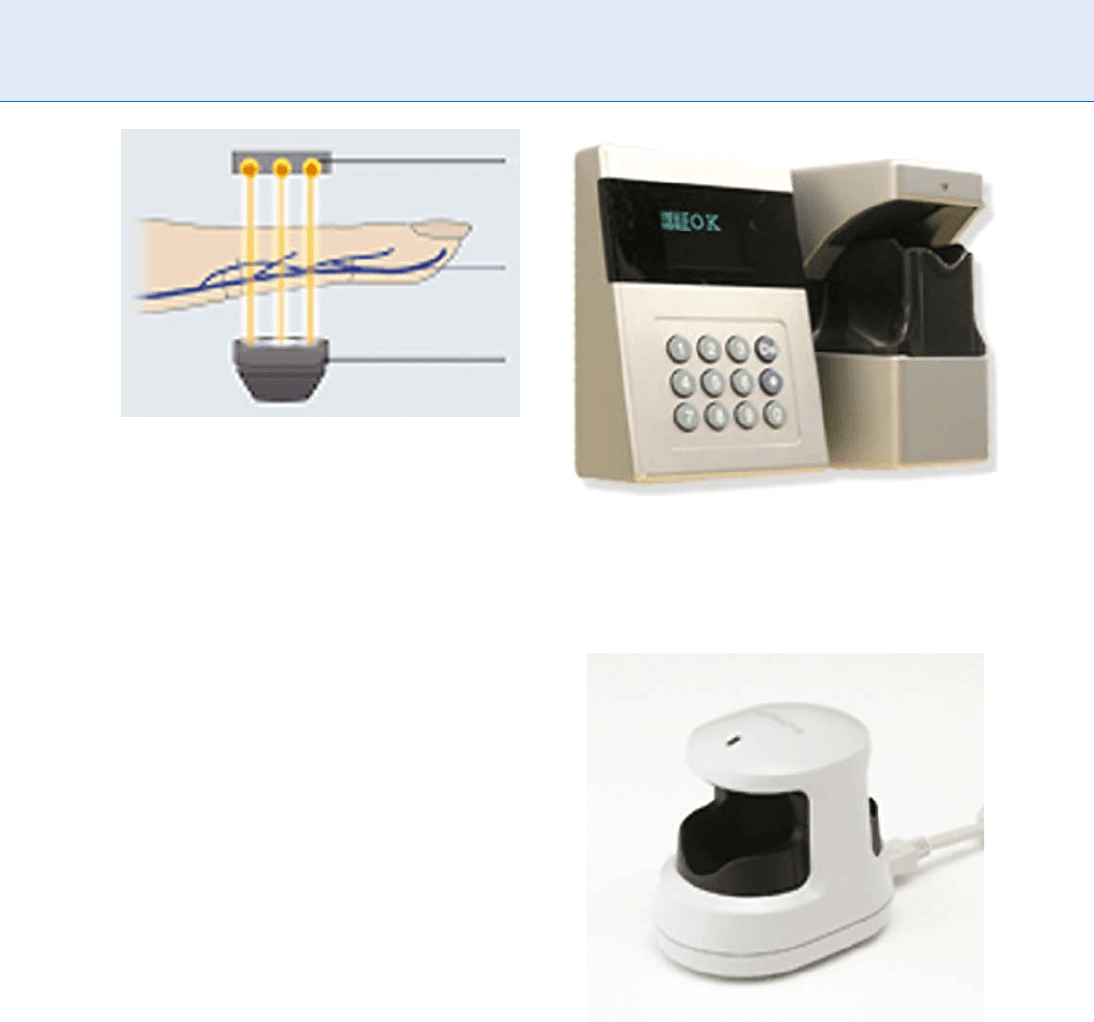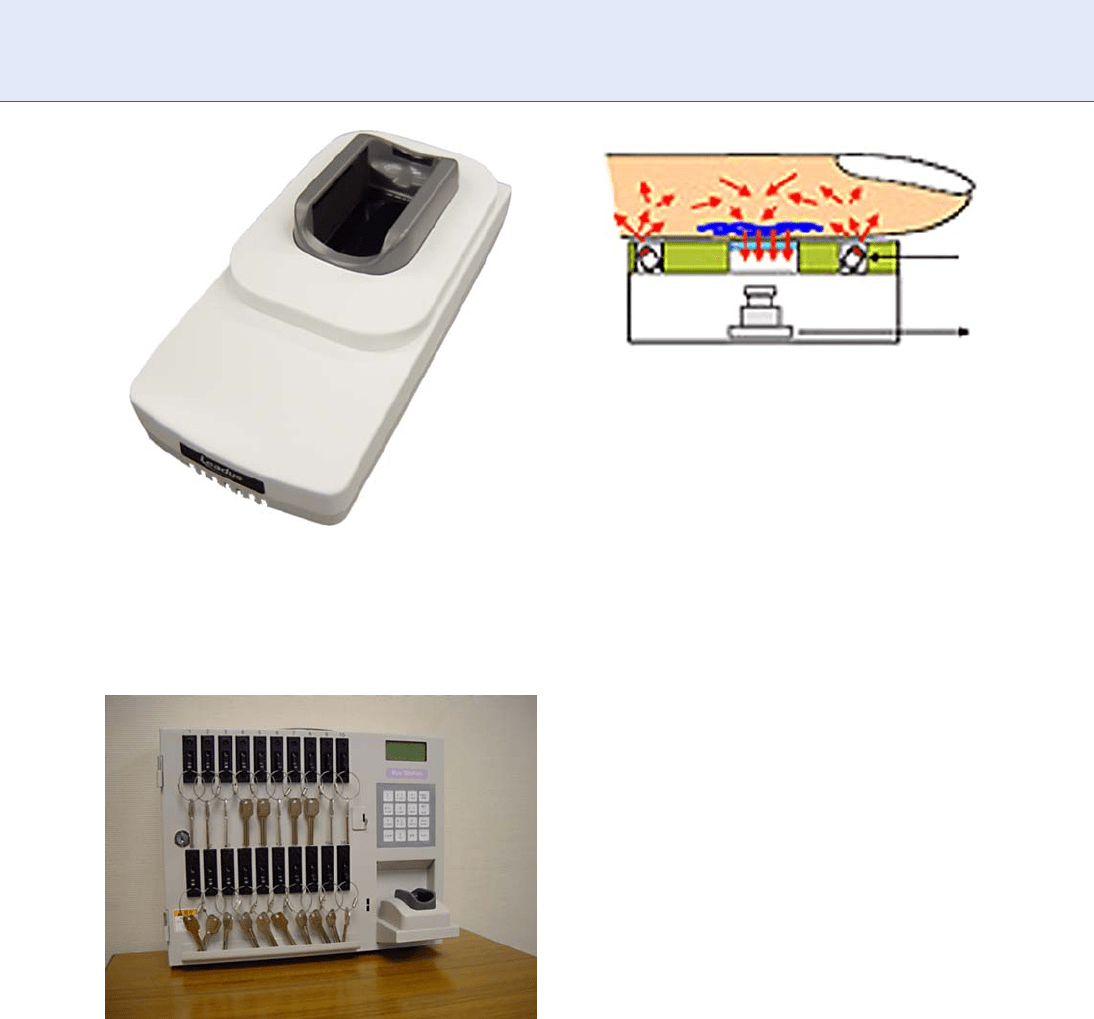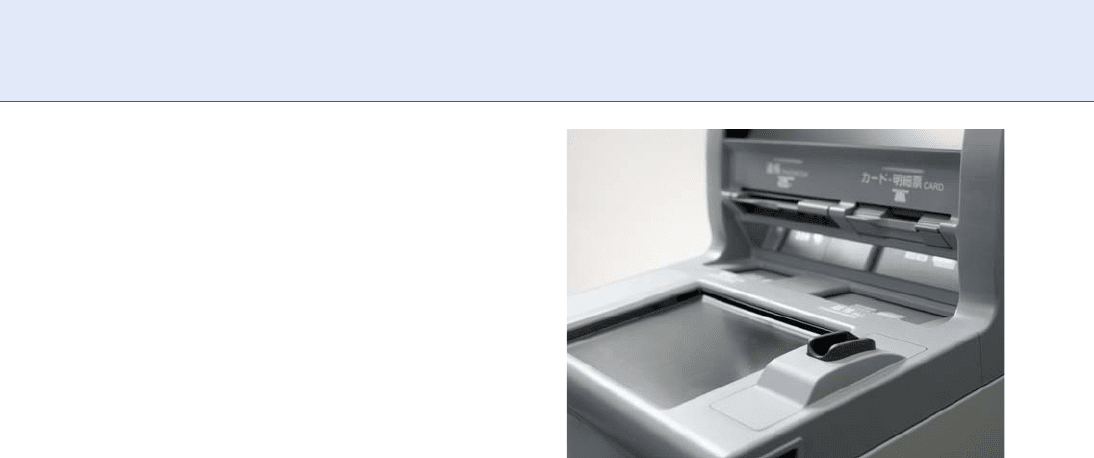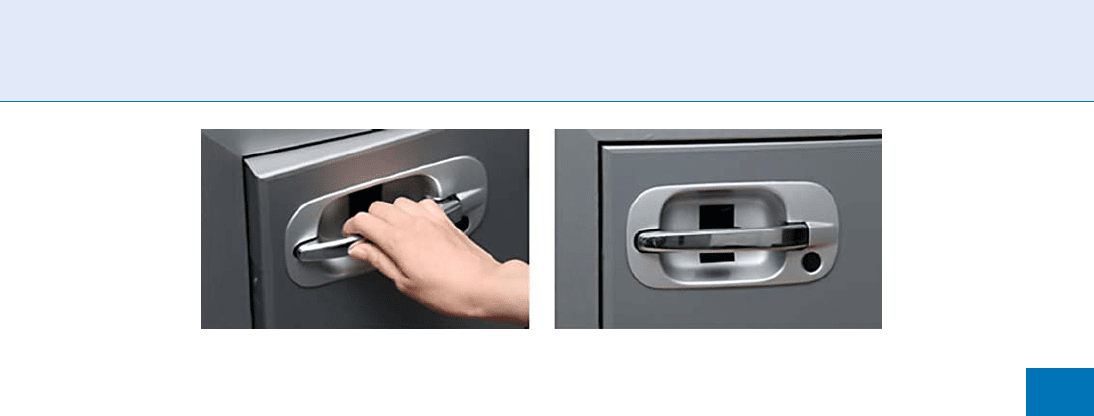Li S.Z., Jain A.K. (eds.) Encyclopedia of Biometrics
Подождите немного. Документ загружается.


The top-lighting imaging method has the following
features.
Robust against environmental illumination.
The light source housing protects the camera
from unwanted ambient lights that deteriorate
the image quality. This structure makes the top-
lighting system the most robust imaging system in
terms of environmental changes.
Stable illumination.
Since the top-lighting system has only one light
source placed right behind the finger, the contrast
attenuation of the captured image is isotropic and
no special image processing is required as long as the
region of interest has enough signal-to-noise ratio.
Since this is the earliest and the most straightforward
implementation of finger vein imaging system, many
commercial models today employ this approach for
both logical and physical access control applications.
One of the earliest commercial finger vein products is a
physical access control system developed by Hitachi
Engineering Co., Ltd. (Its biometrics division was reor-
ganized into Hitachi Information and Control Solu-
tions, Ltd. in 2006 [3].) in 2002. Their product,
SecuaVeinAttestor
1
employed the top-lighting system
and demonstrated very stable performance. This prod-
uct was further improved in terms of robustness in the
following year and achieved even higher accuracy com-
parable to iris recognition (Fig. 3). Figure 4 shows
a logical access control unit PC-KCA100 jointly devel-
oped by Hitachi, Ltd. (Tokyo, Japan) [ 4] and Hitachi
Software Engineering, Co., Ltd. (Tokyo, Japan) [5]in
2006. This product has an application programming
interface (API) that was developed based upon
▶ BioAPI., which enables the biometric device to easily
communicate with many ty pes of systems. Another
interesting example of top-lighting system was demon-
strated by Hitachi, Ltd. in 2007. It introduced a unique
automobile ignition key device (prototype) in Tokyo
Motor show 2007, which allows pre-enrolled drivers
to start the engine by presenting their fingers on
the finger vein reader embedded on the steering
wheel [6].
Finger Vein Pattern Imaging. Figure 2 Top-lighting
system (Courtesy of Hitachi, Ltd.).
Finger Vein Pattern Imaging. Figure 3
SecuaVeinAttestor
1
(Courtesy of Hitachi Information
& Control Solutions, Ltd.).
Finger Vein Pattern Imaging. Figure 4 Hitachi
PC-KCA100 (Courtesy of Hitachi, Ltd.).
430
F
Finger Vein Pattern Imaging

Side-lighting Systems
Side-lighti ng systems typically have a pair of infrared
LED arrays em bedded on the both sides of the pre-
sented finger. The infrared rays emitted by the light
source propagate inside the finger and some of them
reach to the infrared camera placed beneath the finger
as illustrated in Fig. 5. Figure 6 shows an example of
the side-lighting system.
This imaging method has the following features.
Medium-sized enclosure
User-friendly design; low psychological barrier
Unlike the top-lig hting systems, the presented
finger is always within the field of view of the user,
which considerably reduces psychological difficul-
ties of the user while scanning.
High maintainability
It is easy to clean up the camera surface because no
housing covers the optical unit.
Although the side-lighting systems require very ad-
vanced image processing and illumination control tech-
nologies, it is one of the most popular implementations
that is employed by many commercial models. One of
the most widely used applications of this lighting system
is automated teller machines (ATMs). Hitachi-Omron
Terminal Solutions, Corp. (Tokyo, Japan) [7] is the only
supplier of finger vein authentication systems for
banking transactions as of 2007, who has shipped
approximately 40,000 ATMs equipped with finger
vein biometrics (Fig. 7) and enrollment units (Fig. 8)
in Japan since 2005. Hitachi-Omron has also devel-
oped a unique key managem ent system with finger
vein authentication in 2006 (Fig. 9). Hitachi Software
Engineering, Co., Ltd. developed a compact logic al
access control unit called Johmon J200 in 2004,
which employs the side-lighting system.
Bottom-lighting Systems
Bottom-lighting systems have been developed as an
answer to the growing demand for mobile applica-
tions. Typically, the bottom-lighting systems have a
Finger Vein Pattern Imaging. Figure 6 Infrared LED
array (Courtesy of Hitachi-Omron Terminal Solutions,
Corp.) Infrared LEDs are colored in this picture for
visualization.
Finger Vein Pattern Imaging. Figure 5 Side-lighting
system (Courtesy of Hitachi-Omron Terminal
Solutions, Corp.).
Finger Vein Pattern Imaging. Figure 7 ATM equipped
with a finger vein reader (Courtesy of Hitachi-Omron
Terminal Solutions, Corp.).
Finger Vein Pattern Imaging
F
431
F

pair of infrared LED arrays and an infrared camera
embedded on the same surface as shown in Fig. 10.
Although the configuration of the components is
similar to the imaging systems using reflectio n lig ht
such as palm vein readers, the finger has to be touched
to the LED arrays while scanning. The infrared rays
projected into both the tip and the root of the pre-
sented finger propagate inside the fing er and visualiz e
the vascula r patterns in the same manner as the side-
lighting systems. This imaging method has the follow-
ing features.
Cost effective
Very small in volume
Since both the light source and the camera are
embedded on the same surface, it does not require
any three-dimensional structure. This enables the
imaging system flexibly embedded to many devices
including portable devices such as laptop compu-
ters or mobile phones. The volume of Hitachi’s
prototype unit developed in 2005 [8] is as small
as 19 ml (39 mm (depth) 34 mm (width) 15
mm (height)), and further miniaturization is
expected in the near future.
User-friendly design; minimum psychological
barrier
Since the bottom-lighting systems can be em-
bedded to existing hardware without changing the
original appearance of the hardware significantly,
user’s acceptability is the best among the three
systems describe d here. The exterior of the scan-
ning unit is quite similar to the widely used finger
print scanne rs and thus psychological barrier of the
user is ver y low.
High maintainability
Cleaning the bottom-lighting imaging system is
as easy as wiping a flat surface. In addition, it is not
necessary to clean the system as frequent as other
two systems because it has no holes or ditches in
which dust can accumulate.
Hitachi, Ltd. released the first laptop PC equipped
with an embedded finger vein authentication module
in 2005 by using this imaging technology (Fig. 11).
Finger Vein Pattern Imaging. Figure 8 Hitachi-Omron’s
UBReader (Courtesy of Hitachi-Omron Terminal
Solutions, Corp.).
Finger Vein Pattern Imaging. Figure 9 Key management
system with a finger vein reader (Courtesy of
Hitachi-Omron Terminal Solutions, Corp.) Metal enclosure
is removed for demonstration purpose.
Finger Vein Pattern Imaging. Figure 10 Bottom-lighting
system (Courtesy of Hitachi, Ltd.).
432
F
Finger Vein Pattern Imaging

Summary
As described in this essay, finger vein imaging systems
available today can be categorized into three groups:
the top-lighting systems, the bottom-lighting systems
and the side-lighting systems. Because each system has
its unique features, it is very important to choose a
suitable imaging system depending on the application.
In general, the reproducibility of imaging systems is, to
some extent, subject to environmental changes such as
ambient lightings or the conditions of subject, and
of course, none of the three imaging systems over-
viewed here are free from these constraints. In other
words, these changes can be regarded as external
(uncontrollable) parameters and imaging systems
that are robust against these parameters are generally
preferred. The performance of a biometric sy stem can
be improved by suppressing the influence of these
uncontrollable parameters as little as possible; and it
is particularly important to select an appropriate imag-
ing system depending on the application by taking
the variety and the range of these parameters into
consideration.
Related Entries
▶ Finger Vein
▶ Finger Vein Feature Extraction
▶ Finger Vein Reader
References
1. Hitachi Central Research Laborator y, http://www.hqrd.hitachi.
co.jp/crle/
2. Kono, M., Ueki, H., Umemura, S.: Near-infrared finger vein
patterns for personal identification. Appl.Opt. 41(35),
7429–7436 (2002)
3. Hitachi Information and Control Solutions, Ltd., http://www.
hitachi-ics.co.jp/product/english/index_en.htm
4. Hitachi, Ltd., http://www.hitachi.com/
5. Hitachi Software Engineering, Co., Ltd., http://hitachisoft.jp/
English/index.html
6. Hitachi develops finger vein authentication technology for steer-
ing wheels. Hitachi, Ltd. News release, Oct. 2007. http://www.
hitachi.com/New/cnews/071022b.html
7. Hitachi-Omron Terminal Solutions, Corp., http://www.hitachi-
omron-ts.com/index.html
8. Hitachi develops compact finger vein authentication technology
for laptop PCs. Hitachi, Ltd. News release, Oct. 2005. (in Japanese)
http://www.hitachi.co.jp/New/cnews/month/2005/10/1003.pdf
Finger Vein Reader
MIT SUTOSHI HIMAGA
Hitachi-Omron Terminal Solutions, Corp. Tokyo,
Japan
Synonyms
Finger vein scanner; Finger vein imaging device;
Finger vein authentication device
Definition
A finger vein reader is a biometric device that com-
prises at least one optical imaging unit designed to
capture finger vein patterns of an individual and a
digital signal processor that digitizes the captured fin-
ger vein patterns to be utilized as biometric features.
Introduction
Unlike conventional biometric features such as finger
print, vascular network patterns cannot be observed
without using specially designed equipment and
thus, it is extremely difficult to steal or duplicate the
biometric information. The possibility of biometric
Finger Vein Pattern Imaging. Figure 11
Bottom-lighting system (Hitachi Laptop PC Se210)
(Courtesy of Hitachi, Ltd.).
Finger Vein Reader
F
433
F

identification based on human finger vein patterns cap-
tured by transmitting light was indicated by Shimizu in
1992 [1]. However, it was not until Kono et al. devel-
oped a near-infrared finger vein reader prototype and
demonstrated its effectiveness in 2000 that the concept
became reality [2]. Kono et al. further evaluated the
performance of the proposed biometric modality by
using sample data collected from 678 subjects and
reported very positive results in 2002 [3]. In 2007,
Yanagawa et al. demonstrated the diversity of human
finger vein patterns by conducting statistical analysis
based on sample data collected from 506 subjects. They
also proved the feasibility of using finger vein patterns
for personal identification by evaluating false accep-
tance rates (FAR) and false rejec tion rates (FRR) [4 ].
Today, finger vein biometrics is recognized as one of
the most reliable and secure biometric modalities and
is applied to a variet y of security systems.
Features of Finger Vein Modality
The advantages of finger vein biometrics are summar-
ized as below:
1. Accuracy
Finger vein biometrics is one of the most accu-
rate biometric modalities available today. A finger
vein authentication device called UBReader has
been certified as level 3 in the accuracy scale by
the US-based International Biome tric Group
[5, 6]. No other biometric device has been rated at
the highest possible level, level 4. The details of the
evaluation results are reported in the Comparative
Biometric Testing (CBT) round 6 Public Report [7].
2. Usability
Finger vein biometrics can be implemented in
many forms according to the demands and require-
ments of the application. This flexibilit y makes it
possible to design the hardware optimized to a spe-
cific use. For example, Hitachi-Omron’s UBReader,
which was primarily designed for banking applica-
tion, demonstrated very high usability in terms of
indices such as
▶ Failure-to-Enroll Rate (FTE) or
▶ Enrollment Transaction Duration in the CBTand
achieved level 3 in the usability scale of the testing.
3. Compactness/Flexibility
Since the target imaging area of a finger vein
reader is generally smaller than for other vascular
pattern biometric devices (e.g., palm vein or the
back-of-the-hand vein systems), finger vein readers
can be installed into a variety of devices flexibly.
One of the most compact finger vein readers was not
more than 19ml in volume, which made possible for
laptop PCs to embed the device without changing
their appearances. The short focus depth (i.e., the
distance between the camera and the target) makes it
easy to align the finger and, therefore, no hand-
guide or handle bars, which are sometimes necessar y
for other hand vascular devices, are needed.
4. Small templates
The size of finger vein template is typically
some hundreds of bytes per finger. This mean s
that finger vein biometric database can be very cost-
effective because it does not require a large storage
system, compared with other biometrics. This feature
is also preferable for systems which store templates
on a server and transmit them upon request over a
network. Small template size makes a big difference
especially when a high-speed network is not available
or the data traffic is ver y high.
5. Excellent image quality
Since the raw image is the very first input from
which most biometric information is extracted, the
image quality is largely responsible for the overall
performance of the biometric system. All finger vein
readers, commercially available today, utilize near
infrared rays that are projected through the pre-
sented finger. The images captured by using this
method (known as the ‘‘light penetration method’’)
have very high contrast and little noise because most
of ridges and wrinkles on the skin are not imaged.
6. More back-up samples
Unlike most biometric systems, finger vein
biometrics allows more than two templates per
person. Even in the case when one of the enrolled
fingers gets injured and cannot be presented to the
biometric system, it is possible to operate the sys-
tem using other fingers.
The Hardware
Finger vein readers can be classified into three different
groups, depending on the device used, and execution
of the enrollment and aut hentication processes.
The finger vein readers in the first category do not
have an authentication algorithm on the readers which
434
F
Finger Vein Reader

is known as ‘‘match-on-PC’’ readers. Instead, the au-
thentication algorithm is implemented as a computer
software and distributed together with the finger vein
reader. The software is installed to the host PC before-
hand, where the enrollment and authentication pro-
cesses are executed. Since the match-on-PC finger vein
readers do not need a powerful processor, the cost of
the hardware is relatively low compared with the other
two kinds of finger vein readers. Due to the low power
consumption, most of the match-on-PC devices can be
driven by the 5 volts power supplied through the uni-
versal serial bus (USB) interface, which contributes to
the compactness and the portability of the device. Since
the turn-around time of the authentication process is
dependent on the host PC’s CPU power and the com-
munication speed of the interface, the throughput of the
entire system may vary. Although the match-on-PC
readers are widely used for the purpose of logical access
control (e.g., PC log-in), they are increasingly coming
into use for physical access control applications.
The second category is called ‘‘match-on-device’’
finger vein readers. The matc h-on-device reader is
equipped with a CPU that executes both enrollment
and authentication processes inside the reader itself.
The authentication algorithm is implemented in firm-
ware and is typically encrypted when stored on a non-
volatile static memory. One of the biggest advantages of
this system is that all algorithms and data required for
biometric authentication are enclosed in a
▶ tamper-
proof casing and completely separated from the out-
side world. Since all biometric data and algorithms can
be stored inside of the finger vein reader, the risk of
hacking is minimal. Another advantage of this system
is that the match-on-device finger vein readers do not
require high-performance host PCs. In most cases, a
low-performance CPU is enough to communicate and
control the match-on-device finger vein reader, which
makes it possible to integrate cost-effective systems.
The data communications between the host PC and
the finger vein reader are limited because no biometric
data is needed to transfer and therefore no high-speed
interface/network is required. The unit price of these
readers tends to be higher than the match-on-PC read-
ers; however, the match-on-device readers can be used
for a w ide range of applications as they are suitable
for both high-securit y systems and low-cost systems.
Typical applications of the match-on-device readers
include banking systems and physical access control
systems.
The third category is known as
▶ match-on-card
finger vein readers. The authentication algorithm is
implemented as smart card application software and
securely stored onto a smart card together with bio-
metric templates. Upon the host PC’s request, the
match-on-card finger vein reader extracts the biomet-
ric feature of the presented finger and sends an authen-
tication command to the smart card together with the
features. The smart card then executes the authentica-
tion algorithm on its own CPU embedded inside and
evaluates the features transmitted by the finger vein
reader. After the smart card determines whether the
presented finger matches with the pre-enrolled tem-
plate, it transmits a response back to the host PC
through the reader. One of the benefits of using the
match-on-card system is its high security feature. Both
the authentication algorithm and the template data are
securely stored on a smart card that is inaccessible
without taking validation procedures using Secure Ap-
plication Module (SAM). Since these data is never
transmitted outside the card, the risk of template du-
plication is extremely low. From a viewpoint of system
administration, the risk management cost of the
match-on-card system can be dram atically suppressed
because the system does not need to provide protec-
tion for the template data (the card holders are respon-
sible for their own templates, instead). Though the
authentication processing time is slig htly longer than
other two kinds of readers (this is because the smart
card CPUs are slower than the embedded CPUs or
PCs), it does not make much difference especially for
its primary usage, verification. For these reasons,
match-on-card finger vein systems are currently the
most popular biometric banking solution in Japan.
Security Features
Some finger vein readers have a security measure called
▶ liveness detection. It is very important for biometric
systems in general to ensure that the enrolled biometric
patterns are genuine. If a biometric device accepts any
artifact mistakenly and enroll it as a genuine template,
that can be used just like a normal key that can be used
by anyone; if this happens, the security level of the
biometric system becomes no higher than convention-
al keys and locks. In the actual applications, enrollment
procedures typically require an administrator to be
present (who will never allow users to enroll artifacts);
Finger Vein Reader
F
435
F

however, it is still beneficial to have this security measure
because it is also used in the authentication procedure in
order to ensure that the presented sample is from a live
body. Liveness detection can be implemented by either
hardware or software (or both) and there are many
different methods to realize the functionality. The details
of the method employed by finger vein readers are,
however, not publicly available at the time of writing
due to the secure nature of the functionality.
Another security feature that some finger vein read-
ers have is the tamper-proof structure. This structure
enables the system to identify that it has been tampered
with, and in some cases, to disable itself when unautho-
rized person try to dismantle or reverse-engineer the
system. This security measure is especially important
when the biometric system is to be used by open public,
for instance, ATMs. Just like liveness detection, the
details of the tamper-proof structure are highly confi-
dential and no finger vein manufacturer discloses the
mechanism for security reasons.
Applications
Banking transactions
Banking applications are currently the most
popular application of finger vein biometrics. The
first finger vein biometric ATM system was devel-
oped and introduced by Hitachi-Omron Terminal
Solutions, Corp. in 2005. The biometric ATM was
equipped with an open-scanning finger vein reader,
as shown in Fig. 1, and adopted by one of the largest
banks in Japan, Sumitomo Mitsui Banking Corpo-
ration (SMBC, Tokyo, Japan) [8] and later, was
widely adopted by more than 60 financial institu-
tions in Japan including Japan Post Bank Co., Ltd.
[9, 10, 11]. According to a recent survey more than
80% of Japanese financial institutions that adopted
biometric banking systems employ finger vein
biometrics [12] . It is expected that more than
40,000 ATMs in Japan will be equipped with finger
vein readers by the end of 2008, which will make up
approximately 25% of ATMs of the country.
In t ypical finger vein banking systems, each
account holder who wishes to have his or her bio-
metric data enrolled visits a branch of the bank in
person and enrolls two fingers at the teller counter
after prescribed personal identification procedure.
The templates are then stored in a smart card issued
by the bank, on which the matching process is
executed during the authentication process (i.e.,
‘‘match-on-card’’ technology). Since the matching
process is executed against the two templates stored
on the smart card, users can present either of the
two enrolled fingers. Many of the finger vein ATM
networks are connected to each other and the
account holders can use their biometric bankcards
at any ATM that belongs to the participating finan-
cial institutions.
Door access control
Door access control is another popular applica-
tion of the finger vein biometrics. The first com-
mercial application of the finger vein biometrics
was a door access control system called SecuaVei-
nAttestor
1
developed by Hitachi Engineering Co.,
Ltd. in 2002. (Please note that Hitachi Engineering
Co., Ltd. reorganized its biometrics division into
Hitachi Information and Control Solu tions [13],
Ltd. in 2006.) The door access control system is
equipped with a ten-key pad, with whi ch users type
his or her ID number so that it can execute one-to-
one matching (verification). It can also be used
with proximity cards, which allow users to unlock
the door without typing their ID numbers. In
addition, a biometric door access control system
has been developed that works with electric locks
[14, 15]. A prototype automobile entry system
using finger vein bio metrics was demonstrated
in the Tokyo Motor Show in 2005, which enables
pre-registered users unlock the door just by holding
the door handle (Fig. 2).
Finger Vein Reader. Figure 1 Finger vein reader
implemented on an ATM.
436
F
Finger Vein Reader

Logical access control
Logical access control is also a popular and
widely used application. Since host computers
(PCs) are normally equipped with a CPU powerful
enough to execute the matching process in real
time, many finger vein readers for this application
employ the match-on-PC architecture. Hitachi,
Ltd. and Hitachi Software Engineering (Tokyo,
Japan) [16] jointly developed a very compact finger
vein reader for PC called PC-KCA100 in 2006. This
match-on-PC finger vein reader has an applicati on
programming interface (API) based on the widely
recognized international standard BioAPI 2.0,
which enables it to easily communicate with many
types of systems. The power consumption of PC-
KCA100 is so small (less than 2.5 watts) that it can
be driven by the power supplied by the USB inter-
face only.
Other applications
Amano Corporation (Kanagawa, Japan) [17]
developed the first ‘‘time and attendance’’ termi-
nal equipped with a finger vein reader called
AGX250AV in 2007. This innovative termin al can
store up to 1000 finger vein templates and authen-
ticate the users wi thout using an ID card. In addi-
tion to the convenience, AGX250AV eliminates
inappropriate attendance records by impostors
(this is known as ‘‘buddy pu nching’’), which dra-
matically increases the reliability of the time in-
fo rmation system. Alpha Locker System Co., Ltd.
(Kanagawa, Japan) [18] developed the first finger
vein biometric locker FB-BM in 2007. The biomet-
ric locker, which is aimed for public use, has some
tens of doors that can be accessible by presenting a
finger. FB-BM is capable of identifying a pre-
enrolled finger by using one-to-many matching
algorithm and does not require the users to specify
which door to open before presenting their fingers.
Summary
Although finger vein biometrics is one of the latest
biometric technologies, it has already established both
technical and statistical feasibilit y. Finger vein readers
have been successfully applied to a growing array of
applications such as time and attendance or physical
access control systems. Its banking applications remain
one of the largest and the most successful set of appli-
cations for this state-of-the-art biometric modality;
and it is anticipated that more than a quarter of
ATMs in Japan will be equipped with finger vein read-
ers by the end of 2008. Some financial institutions who
adopted other hand vascular biometrics started to
modify their systems to accept finger vein biometric
data, or even replace their systems with finger vein
readers. This trend is expected to continue as the
number of finger vein readers increase, and it is very
likely for the biometric technology to set a new stan-
dard in security applications in the very near future.
Related Entries
▶ Finger Vein
▶ Finger Vein Feature Extraction
▶ Finger Vein Imaging
References
1. Shimizu, K.: Optical trans-body imaging: feasibility of optical
CT and functional imaging of living body. Jpn. J. Medicina
philosophica 11, 620–629 (1992) (in Japanese)
2. Kono, M., Ueki, H., Umemura, S.: A new method for the
identification of individuals by using vein pattern matching of
a finger. In: Proceedings of the Fifth Symposium on Pattern
Measurement, pp. 9–12, Yamaguchi, Japan. (2000) (in Japanese)
3. Kono, M., Ueki, H., Umemura, S.: Near-infrared finger vein
patterns for personal identification. Appl. Opt. 41(35),
7429–7436 (2002)
Finger Vein Reader. Figure 2 Finger vein reader embedded on a door handle.
Finger Vein Reader
F
437
F

4. Yanagawa, T., Aoki, S., Ohyama, T.: Human finger vein images
are diverse and its patterns are useful for personal identification.
MHF Preprint Series, MHF 2007–12, Kyushu University 21st
Century COE Program, Development of Dynamic Mathematics
with High Functionality (2007). http://www2.math.kyushu-u.
ac.jp/coe/report/pdf/2007-12.pdf
5. UB R eader is developed by Hitachi-Omr on Terminal Solutions,
Corp. http://www.hitachi-omron-ts.com
6. International Biometric Group, LLC. http://www.biometricgr oup .
com
7. Theme, M., ed.: Comparative Biometric Testing Round 6 Public
Report. The International Biometric Group (2006)
8. Sumitomo Mitsui Banking Corporation, http://www.smbc.co.
jp/global/index.html
9. Japan Post Bank Co., Ltd. http://www.jp-bank.japanpost.jp/
en_index.html
10. Mizuho Bank, Ltd. http://www.mizuhobank.co.jp/english/
11. Reso na Bank, Limited. http://www.resona-gr.co.jp/holdings/
english/index.html
12. Conducted by Hitachi-Omron, January 2008
13. Hitachi Information and Control Solutions, Ltd., http://www.
hitachi-ics.co.jp/product/english/index_en.htm
14. Electric locks developed by Miwa Lock Co., Ltd. http://www.
miwalock.com/
15. Hitachi, Ltd. http://www.hitachi.com/
16. Hitachi Software Engineering, Co., Ltd.http://hitachisoft.jp/
English/index.html
17. Amano Corporation, http://www.amano.co.jp/English/index.html
18. Alpha Locker System Co., Ltd., http://www.alpha-locker.com/
index.html
Finger Vein Scanner
▶ Finger Vein Reader
Fingermark Identification Procedure
▶ Fingerprint, Forensic Evidence of
Fingerprint
Fingerprint is an impression or image left on a surface
by the friction skin of a finger.
▶ Anatomy of Friction Ridge Skin
Fingerprint Analysis
▶ Fingerprint Features
Fingerprint Authentication
▶ Fingerprint Indexing
Fingerprint Benchmark
▶ Fingerprint Databases and Evaluation
Fingerprint Binarization
Fingerprint binarization is the process of conver ting an
8-bit gray-scale fingerprint image into a 1-bit ridge
image. This is virtually equivalent to thresholding.
Post-processing for the binarized image, such as
smoothing , is also important.
▶ Fingerprint Image Enhancement
Fingerprint Biometric
▶ Fingerprint Recognition, Overv iew
Fingerprint Capture
▶ Biometric Sample Acquisition
438
F
Finger Vein Scanner

Fingerprint Characteristics
▶ Fingerprint Features
Fingerprint Classification
XUDONG JIANG
Nanyang Technological University, Nanyang Link,
Singapore
Synonyms
Fingerprint indexing; Fingerprint pre-matching; Finger-
print retrieval
Definition
Fingerprint classification is a procedure in which fin-
gerprints are grouped in a consistent and reliable way,
such that different impressions of a same finger fall
into a same group. It can be viewed as a coarse-level
pre-matching procedure so that a query fingerprint
needs to be further compared with only a smaller
subset of fingerprints in the database belonging to the
same group. It is often necessary to integrate a classifi-
cation module into a fingerprint identification system
to speed up the database search. A database can be
partitioned into
▶ human-interpretable fingerprint
classes based on Galton–Henry scheme or into
▶ machine-generated fingerprint classes.
Introduction
A fingerprint recognition system captures a user’s fin-
gerprint and compares it with the information stored
in a database to establish or to authenticate his/her
identity. If an identity is claimed, the system compares
the query fingerprint only with the template
corresponding to this identity stored in the database.
This one-to-one matching process is called fingerprint
verification. If no identity is claimed, the system needs
to compare the query fingerprint with all templates
stored in the database to establish the identity. This
one-to-many matching process is called fingerprint
identification. The extension of the one-to-one match-
ing of a verification system to the one-to-many match-
ing of an identification system increases the possibility
of false positive matching. Comparing to the verifica-
tion performance, both accuracy and speed may deteri-
orate significantly if a verification algorithm is naively
extended to solve an identification problem. The per-
formance deterioration could be very serious for large-
scale identification systems as it is directly proportional
to the number of fingerprints in the database [1]. This
problem can be alleviated by reducing the search space
of exact matching. Fingerprint classification, indexing,
or retrieval techniques facilitate the reduction of the
search space. They can be viewed as a coarse-level pre-
matching process before further exact matching in an
identification system. A query fingerprint is first com-
pared to prototypes of the pre-specified classes, bins or
clusters to find its class membership. Then, it is only
necessary to compare the query fingerprint exactly
with a subset of the database that has the same class
membership. For example, if a database is partitioned
into ten groups, and a query fingerprint is matched to
two of the ten prototypes, then the identification sys-
tem only needs to search two of the ten groups of the
database for exact matching. This reduces the search
space by fivefold if fingerprints are uniformly
distributed in the ten groups.
The first rigorous scientific study on fingerprint clas-
sification was made by Sir Francis Galton in the late
1880s [2]. Classification was introduced as a means of
indexing fingerprints to speed up the search in a data-
base. Ten years late, Edward Henry refined
Galton’s work and introduced the concept of finger-
print ‘‘core’’ and ‘‘delta’’ points for fingerprint classifi-
cation [3]. Figure 1 shows the five most common
classes of the Galton–Henry classification scheme
where the core and delta points and the class names are
shown. Henry’s classification scheme constitutes the
basis for most modern classification schemes. Most law
enforcement agencies worldwide currently employ some
variants of this Galton–Henry classification scheme. Al-
though Galton–Henry scheme has some advantages,
such as human-interpretable and rigid segmentation of
a database, only a limited number of classes are applica-
ble to the automated system. For example, most auto-
mated systems [4–8] can only classify fingerprints into
five classes as shown in Fig. 1. Moreover, fingerprints
Fingerprint Classification
F
439
F
